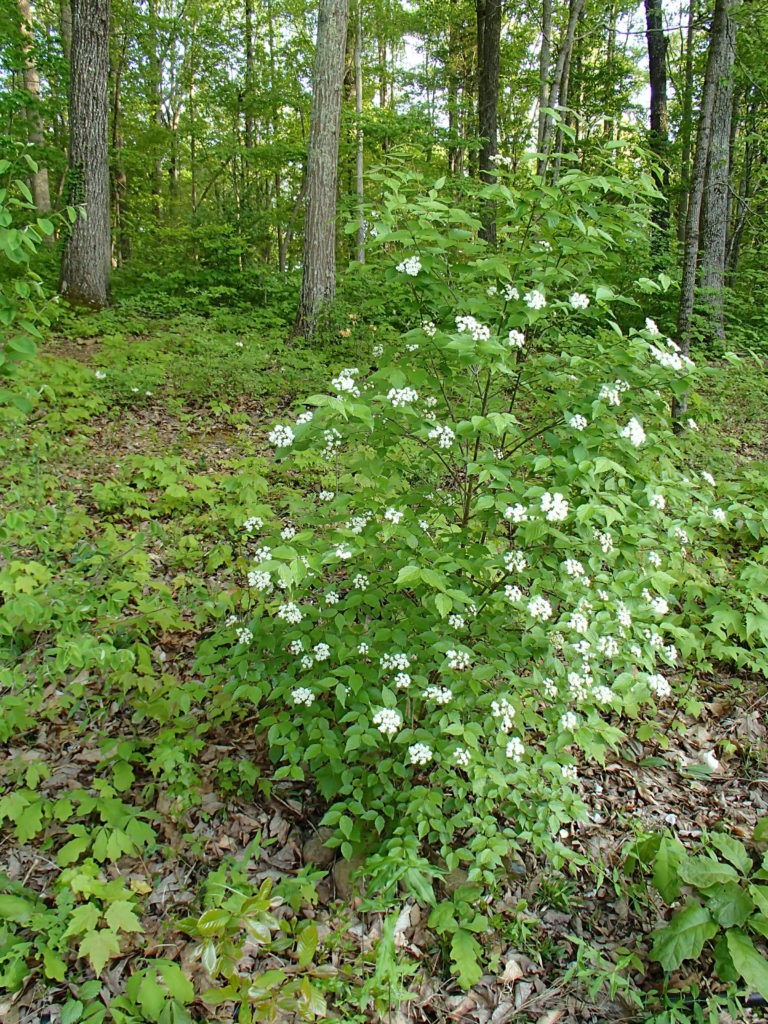This Viburnum — with its showy, flat-topped or domed white flowers and opposite, toothed leaves typical of Viburnums — stands out from its cousins because in addition to being handsome, it is a well behaved, small (6-foot) shrub that plays well with others. Two of them have volunteered on our property in fortuitous understory locations and they are lovely to look at and display their purple-black fruit at a time when little else is available for the birds (mid-summer). Leaves are opposite, simple, and toothed with prominent venation, and they take on beautiful reds and purples in the fall. Downy Arrowwood thrives in partial shade and dry conditions and tolerates higher pH than many of our clay-bred native shrubs – a rewarding, care-free and under-utilized shrub native to piedmont NC.
NURSERY HOURS
Wednesday: 10-4 Thursday: 10-6 Friday-Saturday: 10-4 Sunday: 12-4
Viburnum rafinesqueanum

Key Info
Scientific Name: Viburnum rafinesqueanum Schult.
Common Names: Downy Arrowwood
Family Names: Adoxaceae (Viburnum Family)
Plant Type: Tree / Shrub
Light Requirement: Dappled sun, Full shade-bright, Partial/sunny, Partial/shady, Full sun if consistently moist
Leaf Retention: Deciduous
Flower Color: White
Special Characteristics: Soil adaptable, Tolerates shade, Attracts bees, Attracts butterflies, Showy fruit, Good fall color, Attracts birds, Excellent wildlife food, Tolerates dry conditions
Additional Info
Habit: Single or several straight, slender stems from the crown with smooth or wrinkled gray bark. The root system is woody and spreading.
Height: 6' - 8'
Spread: 4' - 5'
Soil Conditions: Dry to mesic loams and sands, circumneutral pH, sandy loam, loam, clay.
Leaves: Leaves are opposite, 1½–2½ inches long and 1-2 inches across; they are lance-shaped to ovate, tapered to a point and rounded at the base, with distinct teeth along the margins; medium green and generally glabrous, lighter in color and pubescent on the lower surface. The petioles are short (< ¼ inch long) with 2 tiny appendages at the base called stipules (which distinguishes Downy Arrowwood from Southern Arrowwood, V. dentatum which lacks such stipules.)
Flowers (or reproductive structures: White, flat to dome-shaped panicles of flowers 1½–3 inches across at the tips of upper stems. Each floret is about ¼ inch across, consisting of a white corolla with 5 spreading rounded lobes, a shallow light green calyx with 5 short broad teeth, 5 exserted stamens with white filaments and yellowish anthers, and a white pistil. Mildly malodorous.
Fruit: The fruit are clusters of single-seeded berries (technically drupes) which begin green and develop to reddish and finally dark blue-black. These drupes are rounded, about 1/3 inch long, and fleshy and juicy inside. Each drupe has a single stone (hardened seed) at its center. Fruit ripens in mid-summer.
Natural Distribution: Habitats include high quality natural areas, rocky woods, dry slopes, upland woodland openings in the understory of hardwood-dominated forests on fine-textured soils. The dominant canopy trees in these habitats are often oaks (Illinoiswildflowers.info).
USDA Hardiness Zone: 3 to 8
USDA Wetland Indicator Status in NC: UPL
Pollination: Bees, butterflies, other insects.
Wildlife Connections: The berries are eated by gamebirds (grouse, wild turkeys), songbirds and small mammals (squirrels). Fruit and leaves are grazed by hooved browsers.
Propagation: By seed.
